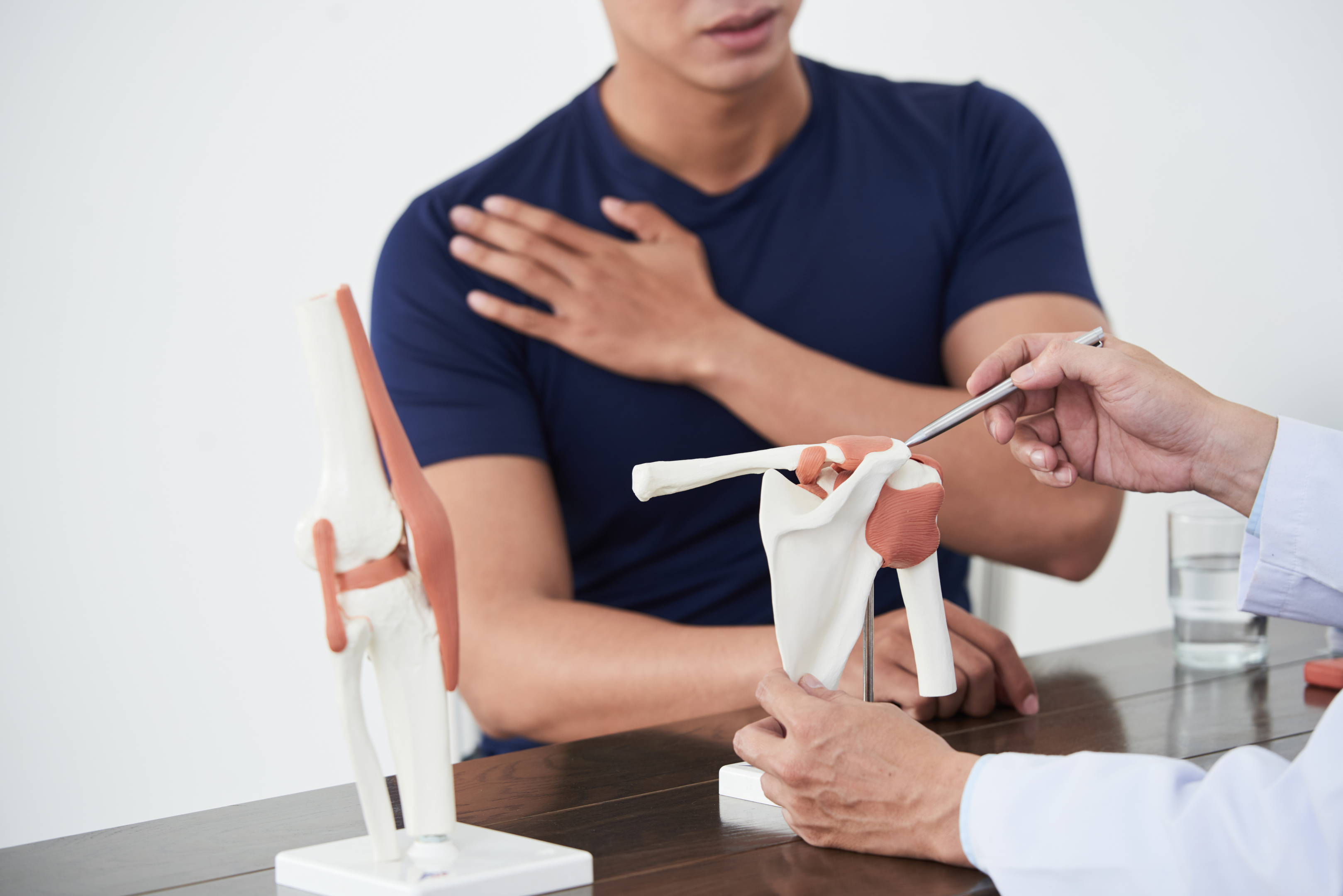
If shoulder pain is limiting your daily tasks, you might wonder, “what doctor should I see for shoulder pain?” Whether to book an appointment with your general practitioner or seek help from a specialist, this guide demystifies the process of choosing the right healthcare provider for your shoulder issues, ensuring you can navigate your way to effective treatment without delay.
Key Takeaways
- Orthopedic specialists should be consulted for shoulder pain that is severe, persistent, or accompanied by symptoms such as swelling and limited movement, as they have expertise in the musculoskeletal system.
- Initial treatment for shoulder injuries may include the RICE method and physical therapy, while persistent pain may require advanced interventions like cortisone injections, arthroscopic surgery, or shoulder replacement.
👉Also Read: Your Journey to Shoulder Recovery Begins Here: Meeting an Orthopedic Doctor
Identifying the Right Medical Professional for Shoulder Discomfort
When shoulder pain disrupts the rhythm of your daily life, it’s a signal that your body is pleading for attention. But whom do you heed this call? The answer isn’t always straightforward. Whether you’re experiencing shoulder pain from a sharp, sudden sensation due to a recent injury or a dull, persistent ache that refuses to abate, making the right choice in medical care is pivotal.
It’s about understanding when to consult a general practitioner and when to escalate your concerns to a specialist who can navigate the complexities of shoulder injuries with precision and expertise.
When to Consult an Orthopedic Specialist
The shoulder, including the shoulder blade and upper arm bone, is a masterpiece of engineering, a complex symphony of tendons, muscles, and bones that grant us an extraordinary range of motion. But when the harmony is disrupted, be it by a rotator cuff tear from an overzealous tennis serve or the jarring impact of a fall that causes a shoulder dislocation, the expertise of an orthopedic specialist becomes invaluable. These are the maestros of the musculoskeletal system, adept at diagnosing and treating the conditions that limit your life’s cadence.
If your shoulder pain impedes daily activities, persists beyond a fortnight, or is accompanied by swelling, redness, and difficulty in movement, it’s time to see an orthopedic. They are the ones who can restore your shoulder’s delicate balance, ensuring you’re back to conducting your life’s orchestra with vigor.
General Practitioners vs. Orthopedic Doctors
General practitioners (GPs), the vigilant sentinels of our health, are often the first ones we confide in when shoulder pain arises. They possess a broad knowledge base, capable of treating a spectrum of ailments, including minor musculoskeletal injuries. For many, a visit to the GP may suffice, especially when the shoulder pain is not severe or persistent. Yet, when the pain’s persistence outstrips their toolkit, GPs play a pivotal role in recognizing when to refer patients to an orthopedic specialist.
Orthopedic doctors, with their laser focus on the musculoskeletal system, step in when the depth of the issue runs deeper, necessitating specialized interventions. In cases of severe trauma or following a high-impact injury, they are the ones who can navigate the complex landscape of shoulder injuries, steering you towards a tailored treatment plan. It’s in these situations where you should see an orthopedic doctor for the best possible care.
Understanding Common Shoulder Injuries and Their Treatments
Every shoulder injury has its own narrative, whether it’s a sprain caused by an unexpected twist or a chronic condition like arthritis that stealthily erodes your joint cartilage. Understanding the common culprits of shoulder discomfort is the first step toward reclaiming your comfort. Injuries such as:
- Sprains and strains
- Dislocations
- Tendinitis
- Bursitis
- Rotator cuff injuries
- Fractures
- Arthritis
not only cause pain but also herald stiffness, limited movement, and a challenging disruption in performing everyday tasks.
Addressing these conditions often begins with the RICE method and can escalate to include an array of treatments, from TENS, physical therapy, ultrasound therapy, and acupuncture to potentially life-altering surgeries.
👉Also Read: Where Does It Hurt? Why an Orthopedic Doctor Asks These Questions
From RICE to Rehabilitation: Initial Treatment Steps
The journey to recovery often starts with the RICE method, a tried-and-true formula of:
- Rest
- Ice
- Compression
- Elevation
This initial defense against shoulder injury plays a crucial role in reducing swelling and inflammation. Alongside RICE, massage therapy, passive manipulation and physical therapy emerge as a beacon of hope, guiding patients through exercises that restore movement and alleviate discomfort.
The shoulder’s convalescence, including cases of frozen shoulder, may be further supported by anti-inflammatory medications, which help to treat shoulder pain and inflammation that often accompany such injuries. When home remedies and over-the-counter pain relievers prove insufficient, a visit to a general practitioner can pave the way for the next steps in medical intervention.
Advanced Medical Interventions for Persistent Shoulder Pain
When the echoes of shoulder pain refuse to fade, it may herald the need for more advanced medical intervention. The orthopedic doctor’s arsenal is rich with options, from cortisone injections that offer a reprieve from inflammation to the precision of arthroscopic surgery that repairs the shoulder from within, addressing issues such as shoulder impingement.
For those whose shoulder injuries mock the efforts of conservative treatments, strategies such as PRP (Platelet Rich Plasma) therapy and even shoulder replacement surgery may be considered to restore function and reduce pain. Such interventions are not taken lightly and are reserved for cases where:
- The pain persists despite the diligent application of nonsurgical methods
- The injury significantly impairs daily activities and quality of life
- There is evidence of structural damage or degeneration in the shoulder joint
It is important to consult with a healthcare professional to determine the most appropriate course of action for your specific situation.
The Role of Massage Therapy and Passive Manipulation in Shoulder Pain Recovery
Shoulder pain can disrupt daily life, but incorporating massage therapy and passive manipulation into your recovery can provide significant relief and promote healing.
Massage Therapy
- Improved Blood Flow: Enhances circulation, bringing nutrients and oxygen to tissues.
- Reduced Muscle Tension: Eases stiffness and spasms.
- Pain Relief: Releases endorphins to alleviate pain.
- Enhanced Range of Motion: Increases flexibility and mobility.
Passive Manipulation
- Joint Mobilization: Maintains and improves joint flexibility.
- Pain Reduction: Gently reduces pain and inflammation.
- Improved Circulation: Boosts blood flow to the affected area.
- Decreased Muscle Guarding: Reduces involuntary muscle contractions.
Together, these therapies offer a holistic approach to recovery, enhancing healing, and improving overall well-being. Consult with a professional to explore how these techniques can help alleviate your shoulder pain and restore function.
Integrative Techniques: Beyond Massage Therapy
Ultrasound therapy delves deep into the tissues, warming and coaxing muscles, tendons, and ligaments back to health with increased circulation and elasticity. Electrical stimulation, meanwhile, serves a dual purpose: it strengthens the muscles and curtails inflammation, and can also facilitate medication delivery directly through the skin.
For those in pursuit of a comprehensive recovery, kinesiology taping can support the shoulder during movement, enhance circulation, and serve as a complement to traditional therapy methods. In some cases, ancillary therapies such as acupuncture and TENS provide additional avenues for pain relief, rounding out a robust treatment plan.
Preparing for Your Orthopedic Consultation
The path to an orthopedic consultation is paved with preparation. Knowing what to expect can alleviate much of the anxiety that surrounds a visit to a specialist, especially when it comes to shoulder pain. A comprehensive exam will likely include:
- A review of your medical history
- A thorough physical examination
- Range of motion testing
- Possibly imaging procedures like X-rays or MRI to peer into the depths of the injury.
To ensure the smoothest experience, arrive armed with the necessary documents and information, ready to engage in a constructive dialogue with your orthopedic doctor and their team.
What to Bring: Medical History and Symptoms Documentation
The tapestry of your medical history is rich with clues that can help an orthopedic doctor unravel the mystery of your shoulder pain. Bringing detailed records of past treatments, surgeries, and any other health conditions provides a backdrop against which your current ailment can be assessed. Include all recent imaging, lab test results, and a comprehensive list of medications and supplements to paint a full picture of your health landscape. Armed with these, and a list of prepared questions and concerns, you’ll be ready to maximize the value of your consultation.
Understanding Diagnostic Procedures

Understanding the diagnostic tools at your orthopedic doctor’s disposal can demystify the process of diagnosing shoulder pain. X-rays offer a glimpse into the structural integrity of your bones, revealing any fractures or misalignments that might be at the root of your discomfort. MRI scans provide a window into the soft tissues of the shoulder joint, uncovering issues that lie hidden from the X-ray’s reach, such as ligament tears or muscle damage.
In some cases, additional imaging tests like PET scans or CT scans may be necessary to obtain a comprehensive view of the shoulder’s condition, ensuring no stone is left unturned in the quest for a diagnosis.
Seeking Specialized Care for Sports-Related Shoulder Injuries

For athletes, the shoulder is not just a joint but a pivotal aspect of performance and passion. Sports-related shoulder injuries are a common plight, particularly in sports that demand repetitive motions, and they require a specialized approach to care. Sports medicine specialists are the vanguards in this domain, combining their knowledge of athletic demands with medical expertise to provide individualized care tailored to the unique needs of the athletic body.
Whether it’s managing an over-stretch of ligaments, navigating the intricacies of a rotator cuff tear, or addressing the challenges of rotator cuff tears, these specialists are adept at employing both nonsurgical management and advanced arthroscopic techniques.
Preventing Further Damage in Athletes
The adage “prevention is better than cure” holds especially true for athletes, where a shoulder injury can significantly impact performance and even a career. Athletes can safeguard their shoulders by adopting the following practices:
- Maintaining good posture
- Engaging in targeted strength training
- Practicing proper body mechanics
- Regular stretching
- Taking rest days
These practices are crucial in allowing the body to recover and reduce the risk of overuse injuries.
Structured preventive programs have been empirically shown to decrease the likelihood of shoulder injuries, exemplifying the importance of a proactive approach to maintaining shoulder health.
Creating a Customized Treatment Plan for Athletes
The treatment of an athlete’s shoulder injury is not a one-size-fits-all affair. A personalized treatment plan takes into account the individual’s sport, position, and overall health to craft a path to recovery that is as unique as their fingerprint. Collaboration between the athlete and the sports medicine specialist is key, ensuring that the plan not only fosters healing but also aligns with the athlete’s long-term health and performance goals.
For conditions such as subacromial impingement syndrome, a multifaceted approach that includes:
- Exercises
- Stretching
- Ice
- Electrotherapy or compression
can alleviate pain and restore function, all while keeping the athlete’s specific demands in mind.
👉Also Read: The Ultimate Guide to Sports Medicine: Enhancing Athletic Performance and Recovery
Get Expert Care for Your Shoulder Pain Today
If shoulder pain is limiting your daily activities, don’t wait to seek help. Choosing the right specialist is crucial for effective treatment and recovery. At Academy Orthopedics, our team of skilled orthopedic surgeons is ready to diagnose and treat a wide range of shoulder conditions, from minor discomfort to complex injuries.
With our expertise and advanced technology, we are committed to helping you regain function and reduce pain. Contact Academy Orthopedics or schedule an appointment to start your journey toward a pain-free life. Let us create a personalized treatment plan to ensure your shoulder’s lasting health.
Frequently Asked Questions
What is a sprain and how does it differ from a strain?
A sprain involves ligament damage from a fall or twist, while a strain results from muscle or tendon stretching due to pulling or twisting movements. Both involve stretching or tearing, but affect different parts of the body.
When is it essential to seek immediate medical attention for shoulder pain?
You should seek immediate medical attention for shoulder pain if the joint looks deformed, you can’t move the arm, experience intense pain, or see sudden swelling after an injury. These could indicate a serious issue that needs prompt medical care.
What role does physical therapy play in the treatment of shoulder injuries?
Physical therapy is essential for managing shoulder pain and promoting recovery. It includes exercises, manual therapy, and electrotherapy to enhance mobility, relieve pain, and improve shoulder function.
What should I bring to my orthopedic consultation for shoulder pain?
You should bring a detailed medical history, relevant imaging or lab test results, a list of medications and supplements, and a personal record documenting the injury to your orthopedic consultation for shoulder pain. It’s also helpful to prepare questions for the doctor and bring a notepad to take notes.
How can athletes prevent shoulder injuries?
To prevent shoulder injuries, athletes should maintain proper posture, engage in strength training, use correct techniques, and stretch regularly. Additionally, ensuring adequate rest days and considering structured preventive programs can also help reduce the risk of shoulder injuries significantly.
